All you need to know about your products!

| 3DNews Vendor Reference English Resource - All you need to know about your products! |
||||||
 |
||||||
|
|
||||||
7900GT and 7900GTX in the SLI modeAuthor:Date: 12/04/2006 AcknowledgementsThe editorial board appreciates Meijin for the GeForce 7900GT/GTX video cards presented for tests. PrefaceWe already got acquainted with NVIDIA's latest video cards - 7900GT and 7900GTX, but that time no word was spoken about performance of these cards when operated in combination, that is, in the SLI mode. Today, we are rectifying this error and are introducing you, dear readers, to the data on performance of NVIDIA's novelties in the combined performance mode. I hope our permanent readers guessed that the news "SLI performance attaining 97%!" was a 1st April joke. The described methodology for plugging in a second video card using a piece of polyethylene was no more than fantasy. In fact, such a high speed boost gained from merging two video cards is not yet encountered in reality. Nevertheless, "every joke has merely a portion of joke, the remaining part is truth". The speed boost gained from plugging in a second video card is there - it is even more than noticeable. But - all in good time. Our test configuration is very well known to you. This time it hasn't undergone any changes. Due to that we can make an adequate comparison of operation results for single 7900GT and 7900GTX video cards versus the same in the SLI mode.
NVIDIA video cards were tested with NVIDIA version 84.20 drivers. This is how our test bench looks with the two 7900GTX video cards fitted in place. Preliminary NotesUnfortunately, for now we can't run tests of two latest video cards in the CrossFire mode. So, to make a comparison versus the results for GeForce 7900GT/GTX in the SLI mode, we made use of the results available at our disposal. Certainly, such a comparison is not quite correct - it would be correct to test X1900 CrossFire with the latest drivers. Nevertheless, I presume we can use these results as approximate estimate for X1900 CrossFire acceptable enough. All the tests were run without overclocking. That is, the video cards were running in the nominal modes. As regards testing in the SLI mode, in one of the test series we wanted to depart from canons somehow and find out how SLI-enabled video cards operate without using a V-Link bridge (which is put on top of the video card). Such operation is allowed by the latest ForceWare drivers albeit a warning is displayed saying that the SLI performance without the V-Link bridge will be lower than expected. That is indeed so. But how lower - we'll see from the tests. BenchmarkingThe diagrams are built in a way that the absolute value in "marks" or FPS are shown in the middle of the results bar. To the right of the bar, there is a percentage of performance change for the SLI combination versus a similar but single video card. That is, for 7900GTX-SLI displayed is the percentage of boost versus a similar single 7900GTX video card. For 7900GT-SLI - as compared to the single 7900GT, and finally for X1900 CF - boost percentage versus the single X1900XTX. We should be aware regarding the latter comparative pair X1900CF/X1900XTX that their operating frequencies are somehow different. X1900 CrossFire Edition offers operating frequencies of GPU/memory which are somehow lower than in X1900XTX, so the overall performance boost produced from merging X1900 CF Edition + X1900XTX is less than it could be with two X1900XTX at the nominal frequencies. Let's start with the synthetic benchmarks. 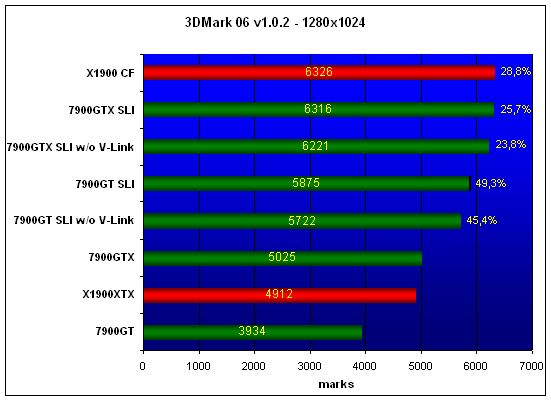 We see that the results for 7900GTX-SLI at 3DMark'06 are practically identical as those for X1900CF, which is evidently caused by the CPU performance. Interestingly, the lack of the V-Link bridge does not strongly affect the results in the SLI mode. 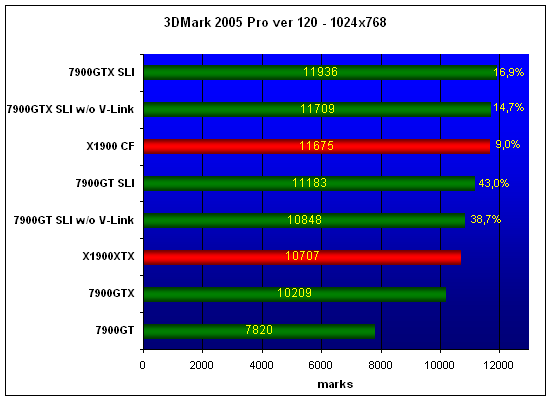 Despite that 3DMark'05 is more "favorable" to ATI's video cards, the CrossFire combination here loses to 7900GTX-SLI. And again - the lack of the V-Link does not affect in any way the performance of video cards in the SLI mode. As regards the pure boost, then the "weaker" video card will offer higher boost if the results are CPU-bounded. That is what we see on the example of 7900GT-SLI. 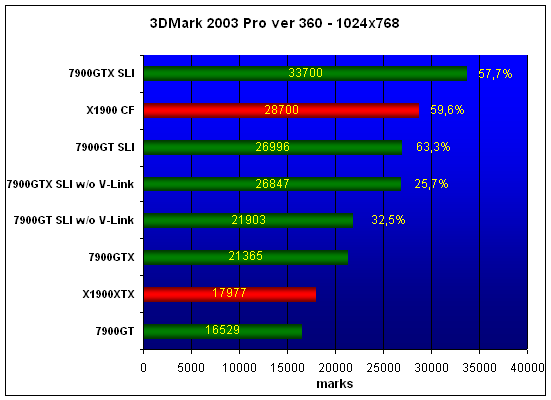 3DMark'03, because of its venerable age, is more sensitive to the "pure speed" of the GPU and is highly responsive to merging two video cards. At this test, NVIDIA video cards have been traditional leaders, and this time the situation hasn't changed. However, it is interesting that the boost for X1900 in CrossFire is a little bit higher than for 7900GTX-SLI. At the same time, the maximum boost - over 60% - is of course attained on 7900GT-SLI. As we can see, all is remarkable at the synthetic benchmarks, but what will the games show? OK. Going on. Half-Life 2Half-Life 2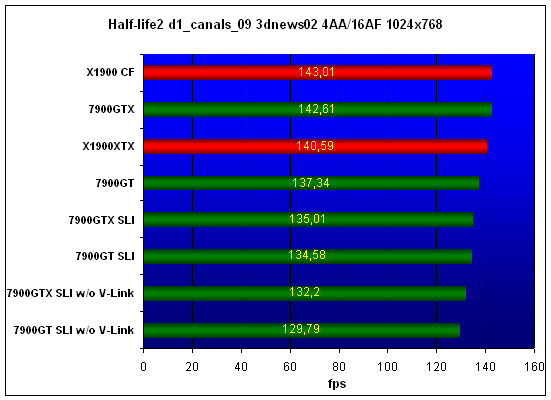 It's been no surprise for quite a while that at 1024x768 in HL2 the results for top-end video cards merged into the SLI prove to be worse at performance than those for the same single video card. The same picture is seen over here as well. Remarkably, again pairs of video cards without the V-Link bridge look worse than similar pairs with the bridge. 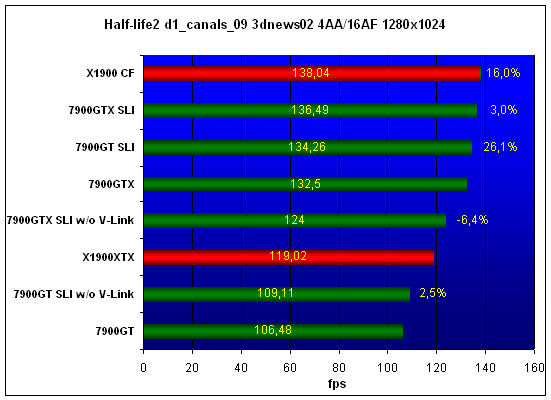 As the resolutions go up, the situation starts getting better. However, the boost gained from the SLI mode is hard to notice because the performance of novelties is extremely high even in the single mode as well. 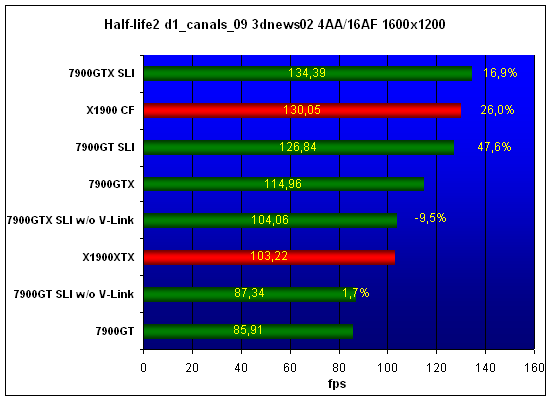 At 1600х1200, the 7900GTX-SLI finally takes a lead over X1900CF. The boost gained from the SLI is seen to the naked eye, but you don't feel like gasping in delight. The insufficient CPU performance is an obstacle. DOOM 3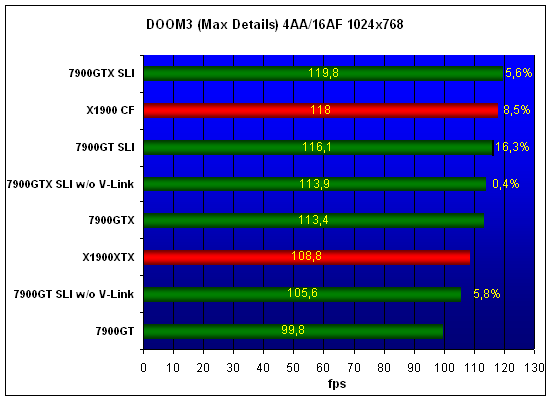 As was expected, at DOOM3 it is NVIDIA cards which take a lead. Again, the computational power of the CPU does not allow the combination of two video cards to "play with muscles" to the full. 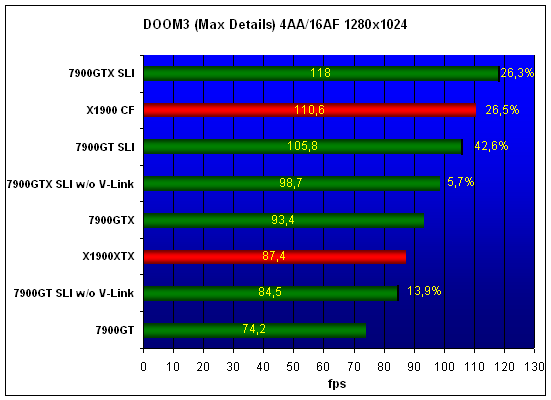 The jagged line of results become more pronounced. The boost from SLI for a pair of 7900GT video cards is seen especially well and amounts to 42%. As regards the SLI without the V-Link bridge, the boost again is no higher than 15%. 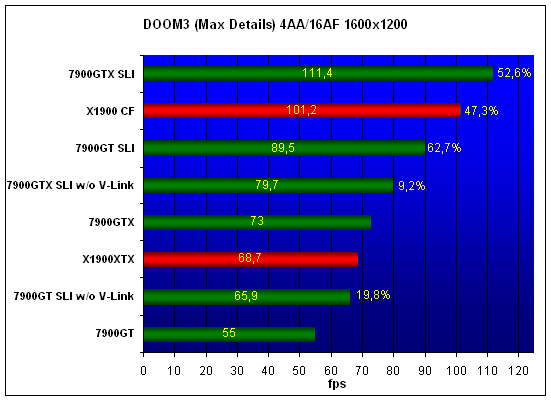 At 1600х1200, the boost gained from consolidated graphic power of two video cards is seen best of all. A pair of two 7900GT adds over 60% to the speed, but even 50% in 7900GTX-SLI is also an outstanding result. F.E.A.R.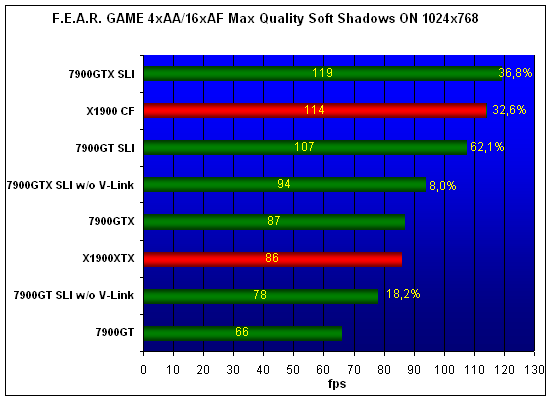 Not so long ago, 100 frames per second at F.E.A.R with the maximum graphic quality settings seemed unreal. Now, it's no longer a problem. We take two powerful video cards and - voila! - over 100 FPS is reached easily and unconstrainedly. While formerly the X1900 CrossFire combination took a lead, now the leadership crown moves to NVIDIA SLI. 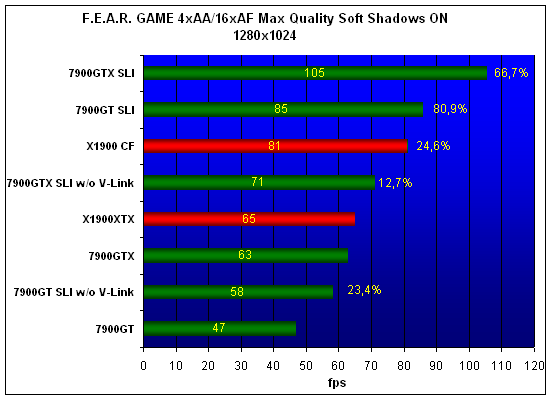 The results shown by two 7900GT video cards in the SLI mode are impressive. The performance boost is over 80%. Well, are there any left who want to talk about the immaturity of SLI? As regards the results for X1900CF and the unexpected drop of boost on increasing the resolution, that is more likely caused by the engineering beta-version of the drivers. We already noted that fact when tested CrossFire on X1900 series cards for the first time. In the near future, we'll still be testing CrossFire and produce a more realistic picture of performance for X1900CF in F.E.A.R. 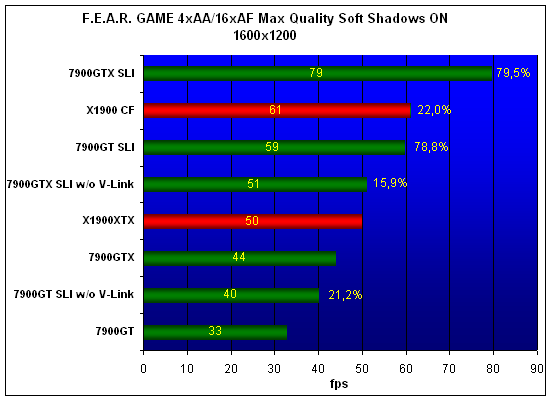 Again, the boost in the SLI mode equals almost 80%. As we know, the boost is normally maximum at the most demanding modes. It is very likely that the 80% performance increase is the ceiling of real efficiency gained from combined computational power of two video cards in the SLI mode. As we see, the gain from using SLI is quite close to 100%, and it's just this proximity to the maximum theoretical values that shows maturity of any technology. Comparative performance boost in applicationsFinally, let's bring in the diagrams of performance boost (as compared to the single video card) in using the SLI technology in various applications. The diagrams are built in a way that shows performance boost percentage for each application in two bars, with the first bar showing the boost produced without the V-Link bridge and the second - the standard SLI mode with the use of the V-Link bridge. 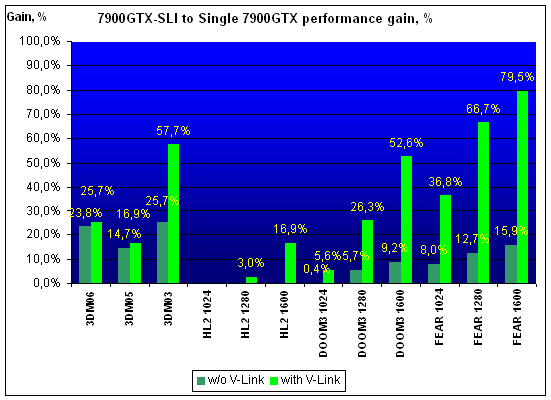 The first diagram is built for a pair for 7900GTX video cards. As was expected, the combination of 7900GTX video cards is best seen in the most demanding modes. That is seen especially well in the F.E.A.R. game. But the most surprising is the boost produced without the V-Link bridge regardless of application and the graphic mode. Moreover, in real applications the lack of V-Link bridge does not allow the overall performance to grow even by 20%. There is some evident restriction. Let's build a similar diagram for the combination of two 7900GT cards and see if such a restriction is preserved for lower-end video cards. 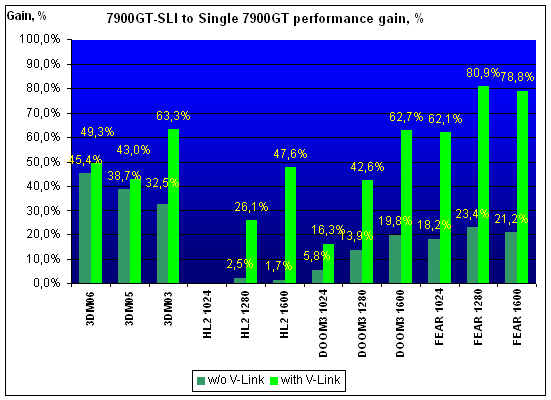 As you see, the picture is very similar. Although we can't state that it's just 20% of performance boost is the limit if the V-Link bridge is not used (in real applications and hard graphic modes) - the tendency is evident. Unfortunately, for now we can't state for sure what the cause of that is. I can merely assume that is a trait of the VPU architecture and the SLI technology. That is, when two video cards are operated the V-Link bridge takes most of the load, whereas the PCI-Express bus bandwidth remains generally idle. Or perhaps some role is played by the difference in the latency of buses. I can assume it's just the architectural trait of SLI that has resulted in that even on middle-end video cards by NVIDIA we can see a connector for plugging in the SLI. We'll know if that is true or not soon after testing two GeForce 6600 video cards with and and without the V-Link bridge. On the whole, since 7900GT is somehow "weaker" than 7900GTX, the boost from merging two 7900GT is more pronounced in most applications. ConclusionThe SLI technology has entered its maturity period. No sooner had that remarkable day come than a new idea is on the way - merging four video cards into a conglomerate called Quad-SLI. But that is a solution for "enthusiasts of the enthusiasts", and from today's test we can arrive at one interesting conclusion. Perhaps it's for the first time on the market when it becomes more advantageous to bus two video cards to merge them into the SLI. Why? The below reasoning is somehow theoretical, but... Just see for yourselves - the recommended price for a single 7900GT is $299, for a single 7900GTX - $499, respectively. With some simple arithmetic we get that the overall cost of two 7900GT video cards is merely 20% higher than the cost of a single 7900GTX, whereas the combined performance for 7900GT-SLI is always higher than that for a single 7900GTX (of course, in the demanding modes, where there is not CPU-boundedness). At F.E.A.R. in the 1600х1200 4AA/16AF, the superiority in performance of 7900GT-SLI over the single 7900GTX is more than 30%! Another advantage is a certain flexibility. If a single 7900GT suffices, then you can be content with the little, and unless new games start lacking performance - you can buy the second video card, because it's just the demanding applications where the advantage is the maximum. Of course, the market prices for video cards are somehow higher, but has always been that way. With time the prices will certainly arrive at the recommended level, and the low prime cost of new NVIDIA chips gives hope for their long and successful life on the market. Which we wish them with all our hearts. |
|
|||||